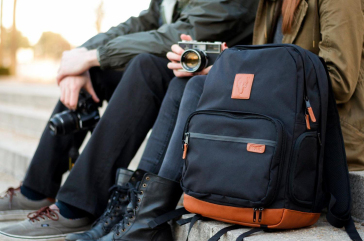Since its launch in 2009, Kickstarter has provided a simplified way for people from all walks of life to obtain funding for creative projects spanning many different fields. The nearly 214,000 launched projects to date have raised an incredible $1.58 billion, with $1.34 billion going toward successfully funded projects, defined as those which reach or surpass their funding goal. According to Kickstarter’s website, 38.95 percent of launched projects — nearly 80,000 — are successful, with nearly 75 percent of these raising less than $10,000. Recently, however, a Fordham student and his two brothers managed to run a Kickstarter campaign for their jointly started company that not only fell into that percentage of projects which found success, but also found itself surpassing the $10,000 mark with money to spare.
Brevitē is a backpack company founded by Brandon Kim, FCRH ’15, and his younger twin brothers, Elliot, an economics and social policy undergrad at Johns Hopkins University, and Dylan, a psychology and marketing undergrad at Syracuse University. Together, the Kim brothers were able to take their idea for a backpack for the “student photographer who was looking to protect their gear without sacrificing honest and intuitive design” and bring it to fruition. Brandon recalls that the concept for their innovative backpack came, in part, from Dylan’s passion for photography.
“Dylan is a passionate photographer,” said Brandon, “but he found himself leaving his camera at home since he had no effective way to carry it with his books for class. All the other camera bags on the market either lacked the space or had no effective way to remove the camera compartment.”
In the summer of 2014, after enrolling in the Rhode Island School of Design (RISD) Industrial Design Summer Program, Brandon found himself in an optimal position to make the brothers’ concept a reality. He decided to create a prototype for the backpack as his final project for the program.
“I brought home the first prototype to show my brother and he immediately saw the practicality of it,” said Brandon. He then went on to explain how he and his brothers spent time critiquing and improving on the initial design, drawing up a number of paper models before seeking out a manufacturer. Then, they needed just one more thing: funding.
“Kickstarter seemed to be the obvious option [for funding], as camera backpacks have seen great success on this platform,” said Brandon. So, in Jan. 26, 2015, after months of preparation, which included increasing Brevitē’s online presence as much as possible, the Kim brothers’ Kickstarter campaign officially launched.
It was an overwhelming success.
Choosing your target fundraising goal is a key part of any Kickstarter campaign. As its own website states, “Funding on Kickstarter is all-or-nothing in more ways than one.” Those who pledge money toward a project are not charged unless the project successfully reaches, or surpasses, its fundraising goal. As a result, overestimating your financial supporting going into a campaign is the catalyst for many failed Kickstarters.
“In our Kickstarter campaign, we aimed to raise $30,000 in order to fund our first manufacturing run,” said Brandon.
They had no problem doing that. The project’s 238 backers, overfunding their project by 27 percent, pledged more than $38,000 by Feb. 26.
“We sold over 230 backpacks on Kickstarter and continue to get more orders every day,” said Brandon. “We are very optimistic for the future and hope to expand our backpack line by producing innovative products.”
According to Brandon, one of the most important factors in running a successful Kickstarter campaign is transparency. For their company’s product, this meant constantly updating current and potential backers with as many photographs of their product as possible, as well as creating a high quality video which showcased its functionality and aesthetics. Brandon described the process as being “incredibly precise and personal,” with many close friends contributing to the campaign by acting in the video and helping to increase their campaign’s media presence.
Brandon and his brothers were also able to find help from the Fordham community in the form of The Fordham Foundry, a partnership between the Center for Entrepreneurship at Fordham University and Small Business Services of the City of New York, which strives to create and grow small business.
“They provided a community of other entrepreneurs to champion me during my campaign,” Brandon said of the Fordham Foundry. “Leading up to the campaign, members were able to offer their particular skills that helped bring us to success. During the prelaunch stage and during the actual campaign, the members within The Foundry served as an invaluable source of information and mentorship.”
For fellow entrepreneurs, student or otherwise, Brandon believes strongly that building a following as early as possible is one of the keys to success. Taking advantage of easy ways to spread the word about one’s company online is a big part of this.
“Automation was very important,” said Brandon. “We used innovative automation to help do more work than our team could handle alone.”
Brandon and his brothers used Thunderclap, among other outlets, to help increase Brevitē’s online and social media presence. Used by the White House and numerous celebrities to spread the word about campaigns of all types, Thunderclap, “allows a single message to be mass-shared, flash mob-style” so that even someone with a small social media following can attract supporters.
To fellow entrepreneurs, student or otherwise, Brandon gives the following advice: “Everything will take one day to learn and one day to execute.”





